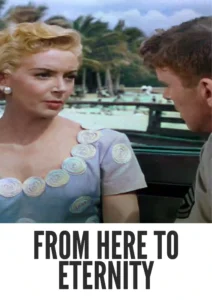Contact: [email protected]
Video Sources 0 Views
- Watch trailer
- From Here to Eternity


Synopsis
Table of Contents
ToggleUnveiling the Timeless Masterpiece: Exploring “From Here to Eternity” (1953) Review

Genre: Drama/Romance
Director: Fred Zinnemann
Cast: Burt Lancaster, Montgomery Clift, Deborah Kerr, Donna Reed, Frank Sinatra
Introduction
In the annals of cinema history, few films have left an indelible mark quite like “From Here to Eternity” (1953). Set against the backdrop of pre-World War II Hawaii, this timeless masterpiece weaves a tapestry of love, betrayal, and redemption. As we embark on a journey through the depths of its narrative, we delve into the significance of its early colorized version and its enduring impact on cinematic storytelling.
Check The Full Colorized Movies List
Check Our Colorized Movies Trailer Channel
Understanding “From Here to Eternity”: Director, Cast, and Genre
Directed by the visionary Fred Zinnemann, “From Here to Eternity” boasts an ensemble cast of legendary performers, including Burt Lancaster, Montgomery Clift, Deborah Kerr, Donna Reed, and Frank Sinatra. Zinnemann’s meticulous direction infuses the film with raw emotion and authenticity, elevating it to the ranks of cinematic excellence. Set within the framework of a drama/romance genre, the film captivates audiences with its compelling characters and intricate plotlines.
Exploring the World of “From Here to Eternity”: Plot and Characters
“At the heart of “From Here to Eternity” lies a tale of forbidden love and personal redemption. The film follows the intertwining lives of several characters stationed at a U.S. Army base in Hawaii in the months leading up to the attack on Pearl Harbor. From the passionate affair between Sergeant Warden (Burt Lancaster) and Karen Holmes (Deborah Kerr) to the poignant journey of Private Robert E. Lee Prewitt (Montgomery Clift), each character grapples with their own demons amidst the backdrop of impending war. The film’s intricate plotline explores themes of honor, loyalty, and the complexities of human relationships.
The Art of Film Colorization
Film colorization, a process that digitally adds color to black-and-white films, has sparked both excitement and controversy in the world of cinema. While purists argue that colorization detracts from the original artistic vision of a film, proponents contend that it offers a fresh perspective on classic works, revitalizing them for contemporary audiences. In the case of “From Here to Eternity,” colorization breathes new life into the lush landscapes of Hawaii, enhancing the visual experience while preserving the film’s timeless narrative.
Early Colored Films: A Brief History
The evolution of colorization techniques in cinema traces back to the early 20th century when filmmakers experimented with hand-painted frames to add color to their films. Over time, advancements in technology led to the development of more sophisticated colorization processes, allowing filmmakers to imbue their works with vibrant hues and textures. The early colored films paved the way for future innovations in cinematography, shaping the visual language of cinema for generations to come.
“From Here to Eternity” and Its Early Colored Version
The decision to release “From Here to Eternity” in a colorized format reflects a commitment to preserving and reimagining classic cinema for modern audiences. By adding color to the film’s evocative imagery, filmmakers aim to enhance the viewing experience while paying homage to its timeless themes and characters. While some may argue that colorization alters the original aesthetic of the film, others view it as an opportunity to introduce new generations to the magic of classic cinema.
The Debate Over Film Colorization
The debate over film colorization remains a contentious topic among filmmakers, critics, and audiences alike. While some champion the practice as a means of breathing new life into old films, others decry it as a form of artistic sacrilege. The debate underscores the tension between preserving the integrity of a film’s original vision and adapting it for contemporary audiences. Ultimately, the decision to colorize a film rests on balancing these competing priorities while respecting the filmmaker’s artistic intent.
Examining “From Here to Eternity” as an Early Colored Film
As we explore “From Here to Eternity” in its early colored version, we are met with a visual feast of vibrant landscapes and emotive performances. The addition of color enhances the film’s immersive quality, allowing audiences to experience the lush beauty of Hawaii and the raw emotions of its characters in vivid detail. While purists may prefer the classic black-and-white aesthetic, the colorized version offers a fresh perspective on the film’s timeless narrative, inviting viewers to rediscover its magic in a new light.
Influence and Legacy: “From Here to Eternity”‘s Impact on Cinema
“From Here to Eternity” has left an indelible mark on the cinematic landscape, inspiring generations of filmmakers and audiences alike. Its powerful storytelling, memorable performances, and evocative imagery have solidified its status as a timeless classic. The film’s influence can be seen in subsequent works that explore similar themes of love, honor, and sacrifice, cementing its place in the pantheon of cinematic greats.
Director’s Cinematic Legacy: Beyond “From Here to Eternity”
Fred Zinnemann’s directorial prowess extends far beyond “From Here to Eternity,” encompassing a diverse body of work that spans multiple genres and themes. His contributions to cinema have earned him critical acclaim and left an indelible imprint on the industry. Zinnemann’s legacy serves as a testament to the power of visionary filmmaking and the enduring impact of storytelling on the human experience.
Themes Explored in “From Here to Eternity”
“From Here to Eternity” delves into a myriad of themes that resonate with audiences on a profound level. From the complexities of love and desire to the corrosive effects of betrayal and disillusionment, the film offers a rich tapestry of human experience. Its exploration of honor, duty, and sacrifice serves as a poignant reminder of the resilience of the human spirit in the face of adversity.
Reception and Controversy Surrounding “From Here to Eternity”
Upon its release, “From Here to Eternity” received widespread critical acclaim, earning numerous accolades, including eight Academy Awards. Audiences were captivated by its compelling narrative, stellar performances, and breathtaking cinematography. However, the film’s colorized release sparked controversy among purists, reigniting the debate over the ethics of altering classic works of cinema. Despite the mixed reception, “From Here to Eternity” continues to endure as a timeless masterpiece.
Where to Watch “From Here to Eternity” Online
For viewers eager to experience the timeless magic of “From Here to Eternity,” the film is readily available on popular streaming platforms. Whether in its original black-and-white format or early colored version, audiences can immerse themselves in the captivating world of pre-war Hawaii and embark on a journey of love, honor, and redemption.
FAQs About “From Here to Eternity”
1. Why was “From Here to Eternity” chosen for colorization?
- The decision to colorize “From Here to Eternity” was driven by a desire to introduce classic films to new audiences and provide existing fans with a fresh viewing experience. Additionally, colorization aimed to breathe new life into the film and showcase its timeless story in a visually captivating manner.
2. Does colorization alter the integrity of the original film?
- Colorization has been a subject of debate within the film community, with purists arguing that it compromises the artistic integrity of the original work. However, proponents contend that colorization offers a new perspective on classic films without detracting from their inherent value.
3. How does colorization impact the viewing experience of “From Here to Eternity”?
- Colorization adds depth and vibrancy to “From Here to Eternity,” enriching the visual narrative and immersing viewers in the lush landscapes of pre-war Hawaii. While some may prefer the timeless aesthetic of black-and-white cinematography, colorization offers a fresh interpretation of the film’s iconic scenes.
4. Is the original black-and-white version still available for viewing?
- Yes, the original black-and-white version of “From Here to Eternity” remains accessible to viewers who prefer to experience the film in its intended format. Many streaming platforms offer both the colorized and original versions, allowing audiences to choose according to their preferences.
5. How does colorization impact the film’s historical accuracy?
- Colorization can enhance the visual authenticity of historical settings, providing viewers with a more immersive experience. However, it is essential to acknowledge that colorization is an interpretive process and may not always accurately reflect the historical context of the film.
6. Are there any significant differences between the colorized and original versions of “From Here to Eternity”?
- While the core narrative remains unchanged, colorization introduces subtle differences in visual aesthetics and atmosphere. Certain scenes may evoke different emotions or highlight previously unnoticed details, offering viewers a fresh perspective on the film’s themes and characters.
7. How has the reception been to the colorized version of “From Here to Eternity”?
- Reception to the colorized version of “From Here to Eternity” has been mixed, with some audiences embracing the enhanced visual presentation and others expressing reservations about altering a classic film. Ultimately, individual preferences and opinions shape the overall reception of the colorized version.
8. Will other classic films receive similar colorization treatments in the future?
- The decision to colorize classic films depends on various factors, including audience demand, technological advancements, and preservation efforts. While some films may benefit from colorization, others may remain untouched to preserve their original artistic vision.
Conclusion
“From Here to Eternity” stands as a testament to the enduring power of storytelling and the timeless appeal of classic cinema. Whether experienced in its original black-and-white format or early colored version, the film continues to captivate audiences with its compelling narrative, memorable performances, and evocative imagery. As we reflect on its enduring legacy, we are reminded of the profound impact of cinema on the human experience and the enduring magic of the silver screen.














